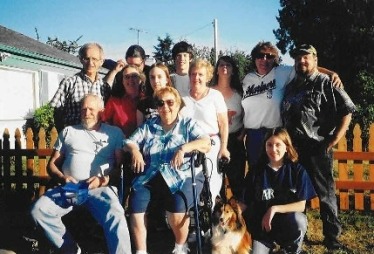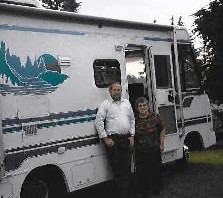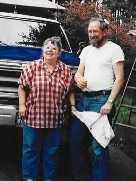Retired Machinist/Sheetmetal Worker Back On The Road
Rafe Ledford is a 69-year-old retired Navy machinist and marine sheetmetal worker who lives in beautiful Port Orchard, Washington. When he retired in 1993 he looked forward to the peace and quiet of this rural setting. For over thirty years his ears had been filled with the banging, clanging, drilling, and pounding that was blasted out non-stop at the Puget Sound Naval Shipyard in Bremerton, Washington.
Rafe spent his entire life working on equipment, metal, and machinery. He served his country in the United States Navy from 1958 to 1962. As a navy machinist he spent his hours below decks in the machinery spaces of military ships, including the USS Hamul(AD-20), USS Bryce Canyon (AD-36) and USS Frontier (AD-25).
Upon his honorable discharge he went to work at the Puget Sound shipyard where he worked on the construction, repairs and overhauls of navy vessels. "The noise, the dirt, the grime…I loved my job but sometimes I really looked forward to the end of my shift."
For all of his efficiency and skill with the tools of a mechanic, Rafe loves the outdoors. He is a man of the woods, an avid camper, hunter, and fisherman. Every fall, he looked forward to heading up into the hills of Eastern Washington to hunt for deer and elk. Even if he never knocked one down or even glassed one, just being in the woods with his buddies was reward enough. Rafe laughs, though, and adds, "I never came home without any meat!"
In retirement, he and his wife Eveline enjoyed traveling in their motor home. Since his retirement, he has driven across country twice. They also spend time enjoying their seven grandchildren and three great grandchildren.
It's no exaggeration to say that retirement was everything it was cracked up to be, until the spring of 2006.
In February of that year Rafe began to experience shortness of breath and slight pain on the right side of his chest. He was unable to work in his yard without stopping to catch his breath. He thought he was suffering from the flu and so did his doctors. He was prescribed antibiotics but his symptoms did not improve.

On May 10, he met with his doctor at the Harrison Memorial Hospital in Bremerton, Washington. Several chest films were taken along with a CT scan. The films revealed a large right-sided pleural effusion. His doctor wanted to remove the fluid.
On May 12, Rafe underwent a thoracentesis at Harrison Memorial. The surgeon removed 450 ml of fluid. After a pathologist examined the fluid, the cytology report noted benign mesothelial macrophages.
On May 24, Rafe returned to his doctors for a follow-up. Upon examination, the doctors found diminished breathing capacity in the right lung. They recommended he see a thoracic surgeon for consideration of a video-assisted thoracoscopy.
On May 26, Rafe underwent a second thoracentesis. The cytology was again negative, which lead his physicians to believe that Rafe was suffering from "asbestos pleuritis versus early mesothelioma." Rafe was advised he should undergo video-assisted thoracic surgery with possible pleurodesis.
On June 8, Rafe was scheduled to undergo a right lateral thoracotomy, multiple pleural biopsies, and partial decortication. The doctor hoped to perform an open biopsy and attempted a video-assisted thoracic surgery, but due to a dense parietal adhesion the surgeon was unable to insert the camera, and altered the procedure to an anterolateral thoracotomy.
Rafe remained in the hospital until June 20. During that time he developed a persistent air leak that later healed. His chest tube was removed and he had no difficulty eating or breathing. Rafe was released to his family, instructed to not engage in vigorous activities, and best of all, to remove his chest tube bandage in 48 hours.

On June 16, the examination of the biopsied tissue revealed stage II epithelial mesothelioma. On June 27, Rafe began to experience shortness of breath and was rushed to the emergency room. He was in new onset atrial fibrillation and was treated with Coumadin. A CT angiogram showing swollen lymph nodes in the central chest cavity. He was treated and sent home.
On June 28, Rafe was ready to discuss the diagnosis with his doctors. They explained the laboratory results from the thoracotomy revealed the extensive spread of the epithelial mesothelioma into the visceral and parietal pleura, the lung parenchyma, and the pericardial tissue. Using an iron stain, the laboratory detected asbestos bodies.
Surgery was ruled out, so Rafe met with an oncologist for evaluation as to possible palliative chemotherapy.
From July of 2006 to February of 2007, Rafe completed eleven rounds of Alimta with Cisplatin. Since that time has returned for CAT scans every two months.
When he was diagnosed, Rafe admits he felt "as low as I have ever felt in life. My outlook of life has really changed, and it's not getting any better. It's one of these deals that I know what's going to happen, but when, I have no idea. As far as I know, there's only one person that does."
Rafe says, "It's really affected us because in the last year we've not been able to do what we wanted to do; that is, to travel or go places, because doctors' appointments and stuff has kept us within the area quite frequently." He continues "We're not able to do stuff with the kids that we'd done before, and the grandkids seem to be taking it in stride, but I don't know about the great-grandkids. They're too young to know what's going on."
Rafe is very concerned about Eveline and the family. He is worried the mesothelioma will eventually split apart the family. "Whenever the kids had something go wrong in their life they came to me, who they go to afterwards, I don't know."
*** POSTED NOVEMBER 9, 2007 ***

